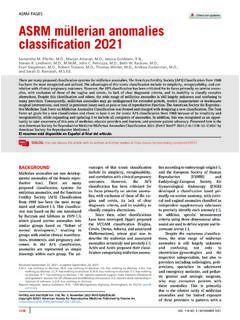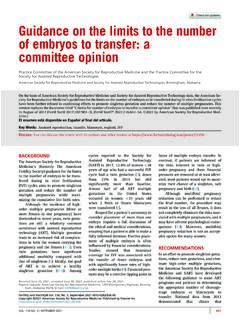Transcription of Evaluation and Treatment of Recurrent Pregnancy Loss - …
1 Evaluation and Treatment of recurrentpregnancy loss : a committee opinionThe Practice Committee of the american society for reproductive MedicineAmerican society for reproductive medicine , Birmingham, AlabamaThe majority of miscarriages are sporadic and most result from genetic causes that are greatly influenced by maternal age. Recurrentpregnancy loss (RPL) is defined by two or more failed clinical pregnancies, and up to 50% ofcases of RPL will not have a clearly defined etiology. (Fertil Steril 2012;-:- -. 2012by american society for reproductive medicine .)Earn online CME credit related to this document at :You can discuss this article with its authors and with other ASRM members your smartphoneto scan this QR codeand connect to thediscussion forum forthis article now.** Download a free QR code scanner by searching for QRscanner in your smartphone s app store or app recognized pregnancyloss is common, occurring inapproximately 15 25% of preg-nancies.
2 The majority of sporadic lossesbefore 10 weeks gestation result fromrandom numeric chromosome errors,specifically, trisomy, monosomy, andpolyploidy(1). In contrast, recurrentpregnancy loss (RPL) is a distinct disor-derdefinedbytwoormorefailedclinica lpregnancies(2). It is estimated thatfewerthan5%ofwomenwillexperiencetwo consecutive miscarriages, and only1% experience three or more(3).WHO TO EVALUATEThe challenge for clinicians is to differ-entiate sporadic miscarriage from losses by patients maynot be accurate. In one study, only71% of self-reported clinical pregnancylosses could be verified in hospital re-cords(4). For the purposes of determin-ing whether Evaluation for RPL isappropriate, Pregnancy is defined asa clinical Pregnancy documented by ul-trasonography or histopathologicalexamination. Ideally, a threshold ofthree or more losses should be usedfor epidemiological studies while clini-cal Evaluation may proceed followingtwofirst-trimester Pregnancy OF RECURRENTPREGNANCY LOSSS tudies that focus on RPL have exam-ined factors related to genetics, age,antiphospholipid syndrome, uterineanomalies, thrombophilias, hormonalor metabolic disorders, infection,autoimmunity, sperm quality, and life-style issues (Table 1).
3 Several recom-mendations have been published(5, 6)regarding the Evaluation and man-agement of RPL. These publications donot support definitive conclusionsabout the causes of RPL because moststudies of Pregnancy loss have focusedon sporadic miscarriage and not putative diagnosis will be made andtreated in approximately 50% ofpatients with RPL(7, 8). The followingoverview acknowledges that ourunderstanding of thisfield is Abnormalities inPregnancy LossVirtually every published set of recom-mendations and reviews on this topicagrees that genetic causes should beevaluated and appropriate treatmentsconsidered(4 6, 9).Unfortunately,clinical genetic testing remainsrudimentary and rarely includesmolecular studies which show promisein helping to elucidate mechanisms forRPL. There is a very high frequency ofsporadic karyotypic abnormalities inproducts of conception while theincidence of karyotypic abnormalitiesin the parents is the examined products ofconception, approximately 60% of earlypregnancy losses are associated withsporadic chromosomal anomalies,primarily trisomies that are, in part,age related(1, 10, 11).
4 Inthoselosseswith a normal karyotype, grossmorphological abnormalities in thefetus diagnosed by transcervicalembryoscopy have been described in18% of patients(12). The risk ofsporadic miscarriage between 6 and 12weeks of gestation in women less than35 years of age is 9% to 12%(13, 14).The risk increases in women over35 years of age due to the markedlyincreased incidence of trisomicpregnancies(10). In women older than40 years of age, the sporadicmiscarriage rate approaches 50%(1, 14,15)(Fig. 1). The risk of aneuploidy ateach age is lower in women with RPLthan in those who undergo sporadicmiscarriages(11).Received June 22, 2012; accepted June 25, : american society for reproductive medicine , 1209 Montgomery Highway, Birming-ham, AL 35216 and Sterility , ,-2012 0015-0282/$ 2012 american society for reproductive medicine , Published by Elsevier COMMITTEETABLE 1 Suspected causes of Recurrent Pregnancy to RPL (%) Recommended screeningSupportive scientific evidenceControversial scientific evidenceNot recommendedCytogenetic2 5 Balanced reciprocaltranslocationsaPL syndrome8 42 (mean, 15)Lupus anticoagulant,anticardiolipin IgGor IgM antibody,anti-b2-glycoprotein IIgG and IgM antibodies,aPL testing for otherphospholipids andb2glycoprotein IIgG or IgM anti-annexin A5,anti-factor XII, anti-prothrombin, IgA aPLsANA, antithyroid (mean, )
5 HysterosalpingographySonohysterographyCo ngenital uterineabnormalitiesUterinefibroids, polypsCervical incompetenceHormonal or metabolicProlactinTSHH emoglobin A1cUncontrolled diabetesor thyroid disease, prolactinPolycystic ovary syndrome andinsulin resistance, lutealphase progesteroneInfectiousNoneBacterial vaginosis, endocervicalinfectionsMale factorsNoneAbnormal sperm DNAP sychologicalNonePsychological effects on uterinereceptivityAlloimmuneNoneMucosal CD16 NK cells,embryotoxic factor, cytokineprofiles, blocking antibodies,HLA typing, anti-paternalleukocyte antibodies,circulating CD16 NK cellsCirculating CD16 NK cellsEnvironnmental, occupational,or personal habitsHistoryNot related to recurrentpregnancy lossNote:ANA antinuclear antibodies; aPL Committee. Recurrent Pregnancy loss . Fertil Steril COMMITTEEIn the Evaluation of RPL, parents should undergo periph-eral karyotyping in order to detect any balanced structuralchromosomal abnormalities.
6 Balanced reciprocal transloca-tions and Robertsonian translocations(6)are observed inabout 2% 5% of couples with Recurrent counseling is important when a structural geneticfactor is identified. The likelihood of a subsequent healthy livebirth depends on the chromosome(s) involved and the type ofrearrangement. When one of the partners has a structuralgenetic abnormality, preimplantation genetic testing (PGT),amniocentesis, or chorionic villus sampling are options todetect the genetic abnormality in the offspring. Treatmentoptions include preimplantation genetic diagnosis (PGD)for specific translocations, with transfer of unaffectedembryos, or the use of donor gametes. While data are limitedcomparing in vitro fertilization (IVF)/PGD versus medicalmanagement (defined as natural conception and observation)for couples with RPL carrying a structural genetic abnormal-ity, two systematic reviews have summarized the success ratesfrom the literature(16, 17).
7 In these reviews, live birth rateswere estimated to be between 31% 35% per cycle for IVF/PGD and cumulative live birth rates were 55% 74% fornatural conception/medical management. Therefore, thereare insufficient data demonstrating that IVF/PGD improveslive birth rate in couples with RPL and a structural geneticabnormality. Based on limited cytogenetic data, 36% 39%of miscarriages in couples with Recurrent Pregnancy lossassociated with a structural genetic factor have anunbalanced structural rearrangement(18, 19). Treatmentoptions should be based on whether repeated miscarriagesare euploid, aneuploid, or due to an unbalanced structuralrearrangement and not exclusively on the parentalcarrier status. Currently, routine preimplantation embryoaneuploidy screening is not justified(20, 21).If the Evaluation of RPL identifies a remediable cause, cy-togenetic analysis of subsequent losses can be employed toevaluate whether the event was random and not a treatmentfailureper se.
8 Testing of the products of conception may alsobe of psychological value to the couple(6). There are pitfalls tothis approach, however, including: the possibility of maternaltissue contamination of the specimen; failure to seek othercauses of RPL if cytogenetic assessment reveals an abnormalkaryotype; and the occurrence of non-cytogenetic embryonicabnormalities ( , dimorphic fetal development has beendocumented via hysteroscopy prior to dilatation and evacua-tion in the setting of normal fetal karyotype)(12). In the eventthat cytogenetic analysis of the products of conception re-veals a 46,XX karyotype, reflex DNA extraction and analysisof a sample of maternal blood by means of microsatelliteanalysis can permit differentiation between a fetal sourcevs. maternal contamination(22).Antiphospholipid SyndromeThe antiphospholipid syndrome is associated with recurrentpregnancy loss .
9 The diagnostic criteria are outlined inTable 2 (23, 24). Although it is generally agreed thatbetween 5% and 20% of patients with Recurrent pregnancyloss will test positive for antiphospholipid antibodies (aPLs),the actual reported range varies between 8% and 42%(24,25). Several groups of investigators have characterized theseantibodies in laboratory-specific assays that have not beenstandardized(23). The most widely accepted tests are for lupusTABLE 2 International Consensus Classification criteria for theantiphospholipid syndrome (APS)(23, 24).APS is present if one of the following clinical criteria and one of thelaboratory criteria are criteria1. Vascular thrombosis2. Pregnancy morbiditya. One or more unexplained deaths of morphologically normalfetuses after the 10thweek of gestation by ultrasound ordirect examination of the One or more premature births of a morphologically normalneonate before the 34thweek of gestation because ofeclampsia or severe pre-eclampsia or recognized featuresof placental Three or more unexplained consecutive spontaneousabortions before the 10thweek of gestation with maternalanatomic or hormonal abnormalities and paternal andmaternal chromosomal causes criteria1.
10 Lupus anticoagulant present in plasma on two or moreoccasions at least 12 weeks apart, or2. Anticardiolipin antibody of IgG or IgM isotype in serum orplasma present in medium or high titer (>40 GPL or MPL or>99thpercentile), on two or more occasions at least 12 weeksapart, or3. Anti-b2glycoprotein-I antibody of IgG and/or IgM isotype inserum or plasma (in titer greater than the 99thpercentile),present on two or more occasions at least 12 weeks Committee. Recurrent Pregnancy loss . Fertil Steril 1 Kaplan-Meier plot showing percentage of women in the recurrentmiscarriage cohort who have had at least one live birth afterfirstconsultation by number of miscarriages beforefirst consultation.(Lund et al. Recurrent miscarriage and prognosis for live Gynecol 2012.)Practice Committee. Recurrent Pregnancy loss . Fertil Steril and Sterility anticoagulant (LA), anticardiolipin antibody (aCL), and anti-B2 glycoprotein I(26)(seeTable 3).








